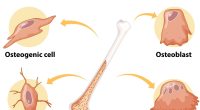In the recent study titled “Targeted delivery of anti-osteoporosis therapy: Bisphosphonate-modified nanosystems and composites,” scholars Shaoyan Shi, Honghao Duan, and Xuehai Ou examine the innovative approach of utilizing bisphosphonate nanosystems for improving drug delivery in the treatment of osteoporosis (OP). OP is a pervasive skeletal disorder that weakens bones, making them fragile and more likely to break, affecting millions worldwide and heavily impacting their quality of life. Traditional treatments with bisphosphonates often suffer from drawbacks such as poor targeting capabilities and limited effective duration, which can significantly diminish their therapeutic efficacy. In response, this review delves into the potential of nanotechnology-enhanced solutions specifically tailored for combatting these limitations.
Focusing on bisphosphonate-modified nanosystems, the authors explore how these advanced formulations can specifically target bone tissue and provide sustained drug release. Such innovations not only enhance the effectiveness of the treatment but also minimize potential side effects by ensuring that the active pharmaceutical ingredients are precisely delivered to the affected areas. The review thoroughly evaluates the synthesis, properties, and both in vitro and in vivo performances of these nanosystems. By integrating recent scientific advancements in this field, the paper aims to shed light on novel strategies that could revolutionize treatments for osteoporosis and potentially other bone-related ailments, underscoring a significant stride towards more personalized and effective healthcare solutions.
The exploration of bisphosphonate nanosystems for advancing osteoporosis therapy is built on a foundation of substantial research dedicated to overcoming the limitations inherent in conventional treatment approaches. Osteoporosis, characterized by reduced bone mass and the deterioration of bone tissue, poses a significant global health challenge, particularly in aging populations. The disease’s stealthy progression often goes unnoticed until a fracture occurs, underscoring an urgent need for more efficient treatment methodologies that not only halt bone loss but also promote bone regeneration.
Bisphosphonates have long been the cornerstone of osteoporosis treatment due to their ability to inhibit bone resorption. However, their effectiveness is frequently hampered by systemic distribution and nonspecific adsorption by bones, which can lead to severe side effects such as osteonecrosis of the jaw and atypical femoral fractures. These complications highlight the critical need for targeted delivery systems that can concentrate the therapeutic action of bisphosphonates directly at the sites of bone loss.
The concept of bisphosphonate nanosystems for focused drug delivery presents a promising breakthrough in this context. The integration of bisphosphonates with various nanocarriers aims to exploit the increased affinity of bisphosphonates for bone tissue. By anchoring these drugs on nanoparticles, such as liposomes, polymeric nanoparticles, or inorganic nanoparticles, their delivery can be more directly aligned with their intended target, thereby enhancing efficacy and reducing adverse effects.
The evolution of bisphosphonate nanosystems for effective osteoporosis management relies on sophisticated techniques in nanotechnology and materials science. These systems are engineered to achieve optimal size, surface charge, and composition characteristics that influence their biodistribution and bone targeting efficiency. Key to their functionality is their capacity to enhance the solubility and stability of bisphosphonates, extending the drug’s biological half-life and facilitating a sustained release mechanism. This controlled release not only maintains the drug concentration within a therapeutic window for an extended period but also reduces the frequency of dosage, thus improving patient compliance.
Moreover, recent investigations into bisphosphonate nanosystems for osteoporosis have also included the examination of composite materials that combine organic and inorganic components, offering dual functions such as bone targeting and promoting bone formation. For instance, bioactive glass nanoparticles coated with bisphosphonates have shown potential in stimulating bone growth while delivering the drug.
In summary, the development of bisphosphonate nanosystems for targeted osteoporosis therapy reflects a comprehensive approach that addresses the multifaceted challenges of this condition. By enhancing the precision of drug delivery, these nanosystems not only promise to improve the outcomes for patients with osteoporosis but also hold potential for application in other bone-related diseases, setting a new direction in personalized medical treatments which could significantly impact the field of orthopedics and beyond.
In the study “Targeted delivery of anti-osteoporosis therapy: Bisphosphonate-modified nanosystems and composites,” Shaoyan Shi, Honghao Duan, and Xuehai Ou utilized a comprehensive methodology to evaluate the efficacy and safety of bisphosphonate nanosystems for targeted osteoporosis therapy. The researchers adopted a multifaceted experimental approach that encompasses both the design and the testing of bisphosphonate-modified nanocarriers, focusing on their physicochemical properties, targeting efficiency, drug release profiles, and biological effects on bone tissues.
Initially, the synthesis of bisphosphonate nanosystems for targeted delivery involved conjugating bisphosphonates to various types of nanoparticles, which included liposomes, polymeric nanoparticles, and inorganic nanoparticles such as hydroxyapatite. The surface of these nanoparticles was chemically modified with bisphosphonates using covalent bonding or adsorption techniques, ensuring a strong affinity towards bone tissue. This customization process was critically fine-tuned to optimize the size, surface charge, and hydrophilicity, factors that significantly influence their bone targeting capability and biodistribution.
Following the synthesis, comprehensive in vitro assessments were conducted. These studies were tailored to evaluate the stability of the bisphosphonate nanosystems for osteoporosis in simulated body fluids, which mimic the conditions within the human body. Drug release kinetics were meticulously monitored using high-performance liquid chromatography (HPLC) to measure the bisphosphonates released from the nanosystems over time, ensuring a controlled and sustained release profile suitable for effective therapeutic outcomes.
Moreover, the bisphosphonate nanosystems were subjected to in vitro cellular tests to ascertain their cytotoxicity and osteoinductive properties. These tests involved culturing osteoblasts and osteoclasts with the nanosystems to observe any effects on cell viability, differentiation, and proliferation which are indicative of biocompatibility and potential bone regeneration capabilities.
For the in vivo evaluation, animal models of osteoporosis were utilized where bisphosphonate nanosystems for enhanced bone targeting were administered. The primary endpoints included the analysis of bone mineral density (BMD) and bone architecture through imaging techniques such as X-ray micro-computed tomography (micro-CT). Additionally, blood samples were analyzed for markers of bone turnover, providing insight into the systemic effects and the specific activity of the nanosystems at targeted bone sites.
The integration of these detailed in vitro and in vivo tests allowed the researchers to create a robust dataset on the performance of bisphosphonate nanosystems for osteoporosis therapy. These methodologies provided crucial insights into the feasibility of this advanced therapeutic approach and underscored the potential of nanotechnology in revolutionizing the treatment of bone-related disorders. Through these systematic studies, the targeted delivery of bisphosphonates via nanosystems was explored, setting a promising path for future clinical applications and development of more personalized and effective osteoporotic treatments.
The research carried out by Shaoyan Shi, Honghao Duan, and Xuehai Ou presented in their study “Targeted delivery of anti-osteoporosis therapy: Bisphosphonate-modified nanosystems and composites” revealed several key findings about bisphosphonate nanosystems for targeted osteoporosis therapy. The study meticulously decoded the potential of these advanced drug delivery systems, showcasing how they could significantly enhance the treatment of osteoporosis by overcoming the limitations associated with conventional bisphosphonate therapy.
One of the primary outcomes of the research indicated that bisphosphonate nanosystems for targeted drug delivery are highly efficient in directing the therapeutic agents specifically to bone sites undergoing resorption. This precision targeting is facilitated by the specific affinity that bisphosphonates have for bone mineral, primarily hydroxyapatite, which is abundant at sites of high bone turnover. By employing various nanocarriers like liposomes, polymeric nanoparticles, and inorganic nanoparticles coated with bisphosphonates, these systems can avoid nonspecific distribution throughout the body, thereby reducing unwanted side effects and increasing the drug efficacy.
Another significant finding from the study was the successful engineering of the nanoparticles’ physicochemical properties to optimize bone targeting. Parameters such as size, surface charge, and hydrophilicity were finely tuned, which directly influenced the biodistribution and increased the accumulation of the drug-loaded nanosystems at the bone resorption sites. This optimization ensures that the bisphosphonate nanosystems for enhanced bone targeting can achieve a higher therapeutic index compared to traditional drug formulations.
The controlled release profiles of these nanosystems represented a breakthrough in managing osteoporosis treatment sustainability. The bisphosphonate nanosystems were shown to maintain a prolonged release of bisphosphonates in a controlled manner, which is crucial in maintaining therapeutic drug levels over extended periods. This sustained release reduces the need for frequent dosing, thereby potentially improving patient compliance and comfort.
From an efficacy standpoint, in vivo tests using animal models provided compelling evidence that these nanosystems not only prevent bone loss but also facilitate the regeneration of bone tissue. The assessment of bone mineral density (BMD) and analysis of bone architecture using advanced imaging techniques like micro-CT confirmed substantial improvements in bone quality and strength in osteoporotic models treated with bisphosphonate nanosystems.
In terms of safety, the in vitro cytotoxicity tests confirmed that the bisphosphonate nanosystems were biocompatible, showing minimal toxic effects on both osteoblasts and osteoclasts at therapeutic concentrations. This aspect is particularly important as it underscores the safety profile of the nanosystems for potential clinical use.
In summary, the research highlighted the multifaceted benefits of using bisphosphonate nanosystems for the targeted delivery of anti-osteoporosis therapy. By improving the drug delivery precision, extending the duration of action, enhancing bone regeneration capabilities, and minimizing side effects, these nanosystems represent a promising advancement in the treatment of bone disorders, particularly osteoporosis. This integrated approach could very well set the stage for future clinical applications and foster the development of more effective and patient-friendly osteoporosis therapies.
The groundbreaking research conducted by Shaoyan Shi, Honghao Duan, and Xuehai Ou on bisphosphonate nanosystems for targeted osteoporosis therapy represents a pivotal shift in the management of bone disorders. As outlined in their study, the ability of bisphosphonate nanosystems for enhancing drug delivery efficiency while minimizing the side effects associated with traditional treatments marks a significant advancement in the field of medical therapeutics. The findings not only demonstrate the efficacy of these innovative systems in improving bone health outcomes but also open new avenues for their application in other bone-related diseases.
Looking ahead, the future directions for the utilization of bisphosphonate nanosystems for osteoporosis and other skeletal diseases are vast and promising. Continued research will likely focus on refining the synthesis process to further customize the physicochemical properties of the nanoparticles to optimize their targeting capabilities and drug release profiles. Advanced manufacturing techniques could play a crucial role in scaling the production of these nanosystems, making them more accessible and cost-effective for widespread clinical use.
Furthermore, the integration of smart technology into bisphosphonate nanosystems for more controlled and responsive drug delivery represents an exciting frontier. The development of stimuli-responsive systems, which can release drugs in response to specific physiological conditions, could enhance the effectiveness of therapies for bone diseases that have varying dynamics and require precise dosing schedules.
Clinical trials will be essential to validate the findings from in vitro and in vivo studies and to establish the long-term safety and effectiveness of these nanosystems in humans. These trials will also be instrumental in determining the optimal dosing and administration methods that maximize patient outcomes and adherence.
Moreover, interdisciplinary collaborations between nanotechnologists, pharmacologists, and clinicians will be instrumental in pushing the boundaries of how bisphosphonate nanosystems for targeted therapy can be tailored to individual patient needs. Personalized medicine, which considers the genetic, environmental, and lifestyle factors of each patient, could be enhanced significantly by incorporating these targeted nanosystems, moving towards more bespoke treatment plans that are designed for maximum efficacy with minimal side effects.
In conclusion, bisphosphonate nanosystems for targeted delivery of osteoporosis therapy encapsulate a transformative approach to treating bone weakening diseases. As research progresses, these systems have the potential not only to improve the quality of life for millions suffering from osteoporosis but also to revolutionize the approach to managing bone health on a global scale. The continuing evolution of bisphosphonate nanosystems for bone disease treatment and their expansion into other therapeutic areas promise to be one of the most exciting developments in medical science, emphasizing a move towards more accurate, effective, and patient-friendly healthcare solutions.









